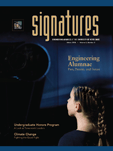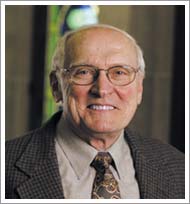
 |
The fences are up! You know they are serious about building you a building when the fences go up.
And they are indeed up, extending south from the new Law School building, which
is already under construction, to well past the site of our new Stinson-Remick
Hall of Engineering. The fences occupy much of the DeBartolo Quad; in fact, to
get to most of the buildings lining Notre Dame Avenue, one first has to go north
from Cushing and Fitzpatrick halls. Along with the rising fences, our plans and our hopes are
also going up, with strategies for building the college of the future
through thoughtfully articulated plans to exploit the new opportunities
that come with expansion. In my last “Signatures” letter,
I described the facilities planned for Stinson-Remick: the expanded,
centrally located McCourtney Learning Center, the Center for Nano
Science and Technology with a state-of-the-art clean room for device
fabrication, our newly emerging Energy Center, an extensive high-tech
materials center, and a 50 kW solar panel system on the roof with
monitors in the learning center describing its use. Another gain
derived from a new building is the opportunity to expand and modernize
those labs that remain in Fitzpatrick and Cushing. When Stinson-Remick
Hall is complete, we will have six (count them—six)
engineering buildings, including the Multidisciplinary Engineering
Research Building on the north end of the campus, focusing on orthopaedics
research, the world-class Hessert Laboratories for aerospace engineering,
and the newest “White Field” building with expanded aerospace
facilities. I believe that there is no better time to be an engineer. For engineers
do more than simply study the world as it is given to them; they
solve the problems associated with that world, with far more sophisticated
tools than have ever been available. Engineers work at all dimensions
(from the mega to the macro to the micro to the nano) and apply the
knowledge of physics, chemistry, and biology to the many problems
that beset mankind. They not only build bridges, but they also study
the materials from which bridges are made at the microscopic level,
to design ways to keep them structurally sound. Engineers build skyscrapers,
and they simulate their behavior under catastrophic conditions, such
as earthquakes or terrorist acts.
I believe that
there is also no better place at this time to study engineering than
at Notre Dame. We are carrying out forefront research that singularly
benefits mankind, and we are performing highly sophisticated computational
modeling of killer storms to avert the destruction of future “Katrinas.” At
Notre Dame we are learning how to rid the earth, sky, and water of
the contaminants that are killing millions of people throughout the
world, and we are developing unique ways to sequester carbon dioxide
to reduce global warming. We are also developing nanoelectronic devices
and circuits that are smaller, faster, smarter, and consume less
energy, along with the systems, architectures, and wireless capabilities
that can provide information nearly instantaneously worldwide at
a scale never before imagined. At Notre Dame we are developing “smart” sensors
and materials for clinical diagnostics, drug delivery, surgery, and
implants, and we are providing unprecedented computational power
to the biologists who are working to eradicate diseases, such as
cancer and malaria. All of these activities are central to the mission
of Notre Dame as a Catholic university. For the past 18 months, I have been privileged to preside over this college.
During this time, we have added several energetic young faculty members with excellent research accomplishments
and incredible enthusiasm for the teaching mission of the University.
In addition, Robert J. Bernhard has joined the University
as the vice president for research and professor of aerospace and
mechanical engineering, and Peter K. Kilpatrick will
soon be joining us as the new McCloskey Dean of Engineering and professor
of chemical and biomolecular engineering (see related story on page
14). We have been awarded more than $32 million in external research
awards and gifts, which does not include a $20 million Gates Foundation
grant for the eradication of malaria — a
project representing true interdisciplinary research between computer
scientists and vector biologists. I have also been privileged to
work with an extraordinary team of faculty and staff, who share a
great love for Notre Dame and its wonderful student body. We welcome, with enthusiasm, our new dean, who is fully prepared
and uniquely capable to elevate the college to become one of the outstanding engineering programs in the United
States. I have no doubt that when the fences come down just two years
from now, Notre Dame’s College of Engineering will be poised
to unleash the next level of intellectual firepower, teaching, and scholarly activity that
is essential for Our Lady’s University to move forward as the “great
Catholic university” which remains, as always, our goal. |
||||||


